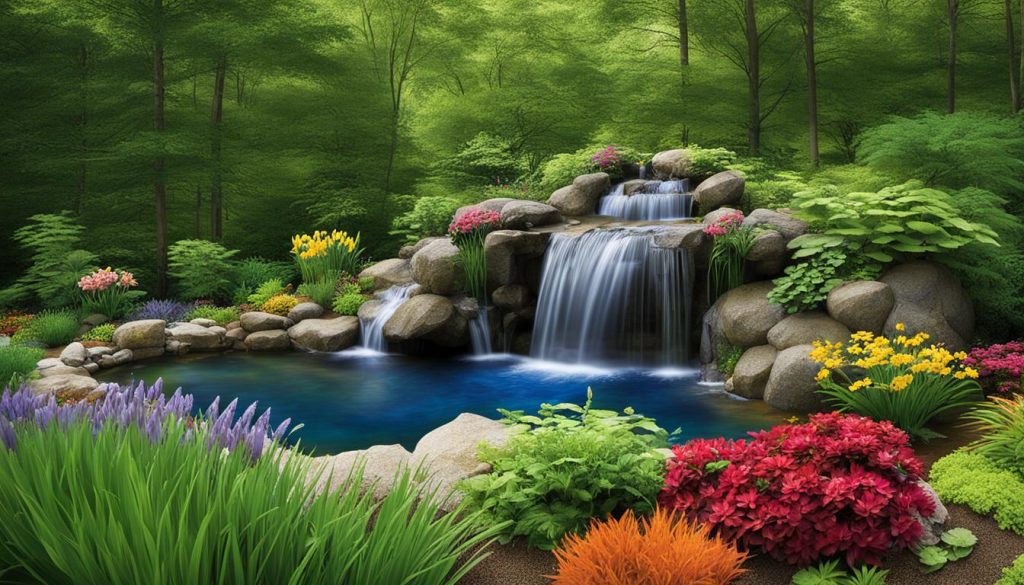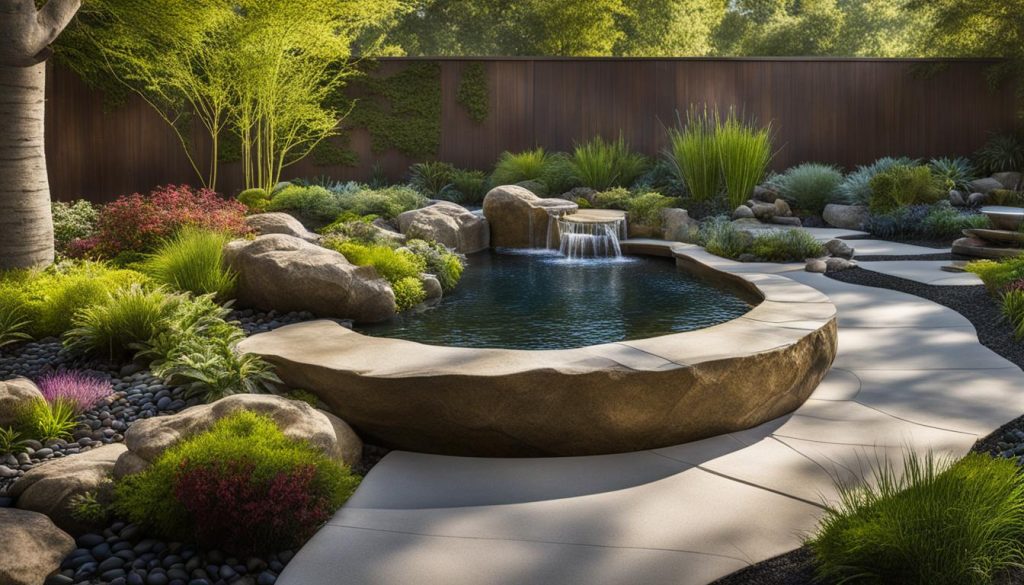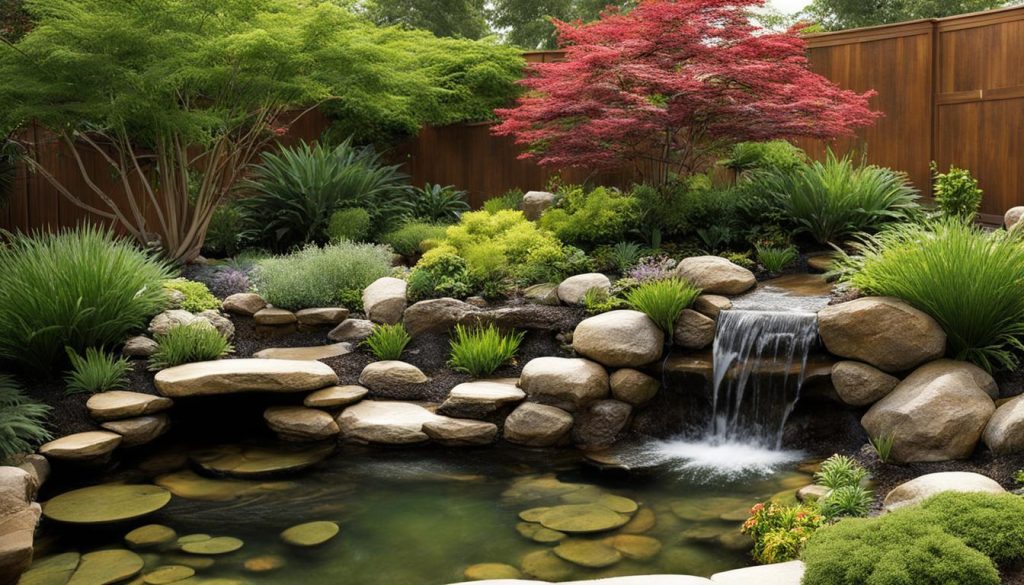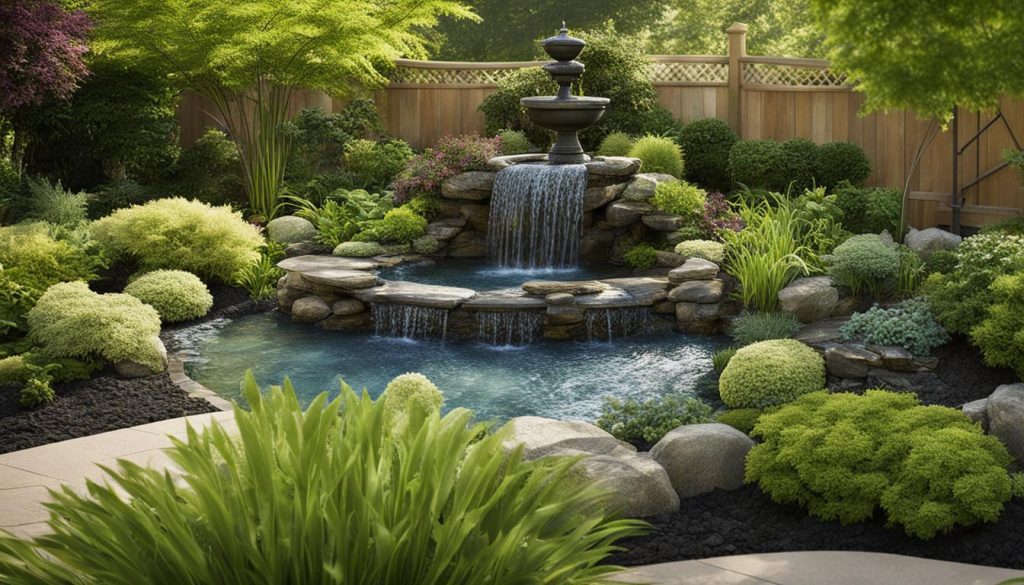Welcome to our guide on water feature landscaping! If you’re looking to transform your outdoor space into a peaceful oasis that seamlessly blends with Canada’s natural beauty, you’ve come to the right place.
Water features are a fantastic way to add depth and serenity to any outdoor area. From the gentle trickle of a small fountain to the imposing presence of a large waterfall, a well-designed water feature can create an inviting ambiance that soothes the senses and creates a sense of tranquillity.
In this article, we’ll walk you through the art of water feature landscaping and how you can use it to create your ideal outdoor space. We’ll cover everything from understanding the different types of water features to planning your landscape design and bringing your vision to life. So, let’s dive in!
Key Takeaways
- Water feature landscaping can enhance the beauty and tranquility of outdoor spaces.
- Water features come in different types and sizes, each with unique benefits.
- Proper planning and budgeting are essential before implementing water features in your landscape design.
- Integrating water features into your outdoor space requires thoughtful implementation and maintenance.
- Water features offer benefits beyond aesthetics, such as promoting relaxation and attracting wildlife.
Understanding the Magic of Water Features
Water features are not just pieces of decoration; they can truly transform an outdoor space, creating a sense of tranquility and beauty. As landscaping professionals, we understand the impact water features can have on a landscape design, and we are here to guide you through the different types of water features and how to incorporate them into your design.
The Benefits of Water Features in Landscaping
Water features are not only visually appealing, but they also provide a range of benefits. For example, the sound of flowing water can have a calming effect on the mind, reducing stress levels and promoting relaxation. In addition, water features can attract wildlife, such as birds and butterflies, adding to the natural beauty of your outdoor space. Water also helps purify the air, making it a great addition to any space with poor air quality.
Types of Water Features
| Water Feature Type | Description |
|---|---|
| Ponds | Large bodies of water that can hold fish and aquatic plants. |
| Waterfalls | Cascading water over rocks or other materials, creating a dramatic effect. |
| Fountains | Water sprays from a central point, often decorative, with different nozzle options. |
| Streams | Flowing water that can be designed to traverse throughout a landscape. |
Each type of water feature offers a unique aesthetic and can be incorporated in different ways depending on your design goals and preferences. Ponds are great for larger outdoor spaces, while fountains can be used in smaller areas to create a focal point. Waterfalls and streams provide a more natural look for those aiming for a rustic feel.
Incorporating Water Features into Your Landscape Design
When designing your landscape with water features, it’s important to consider the overall look and feel of your outdoor space. Water features should blend seamlessly into the surroundings, complementing existing elements like plants and hardscaping. Also, consider the practicalities of installation, maintenance, and repair costs. For example, a large pond may require a lot of maintenance, while a small fountain is easier to maintain and repair.
With thorough planning and design, water features can enhance the natural beauty of your outdoor space and create a relaxing and tranquil environment. Our team of experts is here to help guide you through the process and bring your vision to life.

Planning Your Water Feature Landscape
Designing a water feature landscape requires careful planning to ensure that it integrates seamlessly with the rest of your outdoor space. Here are some important factors to consider:
Site Analysis
A thorough site analysis is crucial in determining the best location for your water feature. Consider factors such as sun and shade patterns, soil conditions, and drainage. This analysis will also help you determine the optimal size and shape of your water feature.
Budgeting
Before embarking on any landscape design project, it’s important to establish a budget. Water features can range from simple and affordable to elaborate and costly. By having a budget in mind, you can determine the type and size of water feature that works best for you.
Choosing the Right Water Feature Elements
Once you’ve completed your site analysis and established a budget, it’s time to choose the specific water feature elements that you want to include in your design. Consider factors such as aesthetic appeal, functionality, and maintenance requirements. Common water feature elements include fountains, ponds, and streams.
Integrating Water Features with Other Landscape Design Elements
When designing your water feature landscape, it’s important to ensure that it integrates well with the rest of your outdoor space. Consider factors such as colour schemes, plant selection, and lighting. By incorporating water features with other design elements, you can create a harmonious and cohesive outdoor environment.
By carefully planning your water feature landscape, you can create a serene and inviting outdoor space that enhances the beauty of Canada’s natural surroundings. With the right design elements and planning, your water feature landscape can become a peaceful escape and a source of tranquility for years to come.

Implementing Water Features in Your Outdoor Space
Once you have a solid plan in place for your water feature landscape, it’s time to bring it to life. The implementation process can vary depending on the type of water feature you’ve chosen and the complexity of your design. Here are some general tips to keep in mind:
Installation Techniques
Proper installation is key to ensuring the longevity and functionality of your water feature. Depending on the size and complexity of your feature, you may want to consider hiring a professional landscaper or water feature contractor to handle the installation process. However, if you are confident in your DIY skills and have some experience with landscaping, you may be able to tackle the installation on your own.

It’s important to follow the manufacturer’s instructions carefully and to pay attention to details such as proper grading, filtration, and drainage. You’ll also need to consider the type of liner to use for your feature and the appropriate location for your pump and filtration system.
Maintenance Tips
Once your water feature is up and running, you’ll need to keep up with regular maintenance to ensure it stays in top condition. Here are some basic maintenance tips to keep in mind:
- Check the water level regularly and top off as needed.
- Clean the water feature at least once a month to prevent algae buildup.
- Inspect the pump and filtration system regularly to ensure they’re functioning properly.
- Winterize your water feature if you live in a colder climate to prevent damage from freezing temperatures.
Integrating with Your Outdoor Space Design
A water feature can be a stunning centerpiece for your outdoor space, but it’s important to ensure it blends seamlessly with the rest of your design. Consider the overall style and theme of your space to select a water feature that complements it. For example, a sleek modern fountain might work well in a contemporary garden, while a natural-looking pond might be a better fit for a rustic backyard.
Additionally, think about how you can incorporate other elements into your water feature landscape to create a cohesive design. For example, you might plant water-loving vegetation around your pond or add a seating area nearby to encourage relaxation and enjoyment of your new feature.
Implementing a water feature in your outdoor space can be a rewarding and enjoyable process. By following these tips and carefully planning and maintaining your feature, you can create a stunning and tranquil addition to your landscape design.
Enhancing Your Outdoor Experience with Water Features
Now that your water feature landscape is complete, it’s time to sit back, relax, and fully embrace all the benefits it has to offer for your outdoor experience.
Creating a Soothing Ambiance
The sound of flowing water has a calming effect on the mind and body, making it the perfect addition to any outdoor space where you want to unwind and de-stress. Whether you’re practicing yoga or simply enjoying some quiet time, the tranquil sounds of your water feature can soothe your soul and make you feel more relaxed and rejuvenated.
Attracting Wildlife
Water features provide a natural habitat for various forms of wildlife, such as birds, butterflies, and dragonflies. These creatures can add to the beauty and serenity of your outdoor space while also helping to maintain the ecosystem. You can observe their natural behaviors and movements while enjoying your time in nature.
Improving Air Quality
Water features can also help improve the air quality around your outdoor space. The sound of water and the movement of air created by the flow of water can help to break up pollutants and allergens, leading to cleaner and fresher air. This can make it more enjoyable for you and your loved ones to spend time outdoors, especially for those with allergies or respiratory issues.
By incorporating water features into your landscape design, you can create a truly magical outdoor space that enhances your overall quality of living. We hope our guide has been helpful in bringing your water feature landscaping dreams to life!
FAQ
What is water feature landscaping?
Water feature landscaping involves incorporating various water elements, such as fountains, ponds, or waterfalls, into outdoor spaces to create a serene and inviting environment.
Why should I consider water feature landscaping?
Water features have the ability to enhance the beauty of your outdoor space and create a tranquil atmosphere. They can also attract wildlife, improve air quality, and provide a soothing ambiance.
What types of water features can I incorporate into my landscape design?
There are various types of water features to choose from, including fountains, ponds, waterfalls, and streams. The choice depends on your preferences, space availability, and overall design aesthetic.
How do I plan my water feature landscape?
Planning your water feature landscape involves conducting a site analysis, setting a budget, and choosing the right water feature elements that complement your overall design. It’s important to consider factors such as space constraints, maintenance requirements, and the desired impact on the outdoor space.
Can I install water features myself or should I hire a professional?
The installation of water features can vary in complexity depending on the type and size of the feature. While some smaller features can be DIY projects, larger and more intricate designs may require professional assistance to ensure proper installation and functionality. It’s important to consider your own skills, resources, and time availability when making this decision.
How do I maintain my water feature landscape?
Proper maintenance is crucial to keep your water feature landscape in optimal condition. Regular maintenance tasks include cleaning debris, checking water levels, inspecting pumps and filters, and ensuring proper water circulation. It’s also recommended to follow manufacturer instructions and seek professional help for more complex maintenance tasks.
Will water features increase my utility bills?
The impact on utility bills will depend on the type of water feature and its energy consumption. While some features, like fountains, may require electricity, others, such as natural ponds, rely on natural water sources. It’s important to consider energy-efficient options and factor in ongoing maintenance costs when assessing the overall financial impact.
Can I incorporate water features into a small outdoor space?
Yes, water features can be scaled to fit smaller outdoor spaces. There are various compact options available, such as wall fountains or container water gardens, that can add a touch of tranquility to even the tiniest outdoor areas.
Are water features suitable for all climates?
Water features can be adapted to different climates. In colder regions, it’s important to consider features that can withstand freezing temperatures, such as pond heaters or waterfalls with proper drainage. In warmer climates, factors like evaporation and water conservation need to be taken into account when designing and maintaining water features.
Can water features attract mosquitoes?
Stagnant water can potentially attract mosquitoes. However, proper maintenance, such as regular water circulation and the use of mosquito control methods, can minimize the risk. Additionally, incorporating fish or aquatic plants, like water lilies, can help keep mosquito populations in check.

